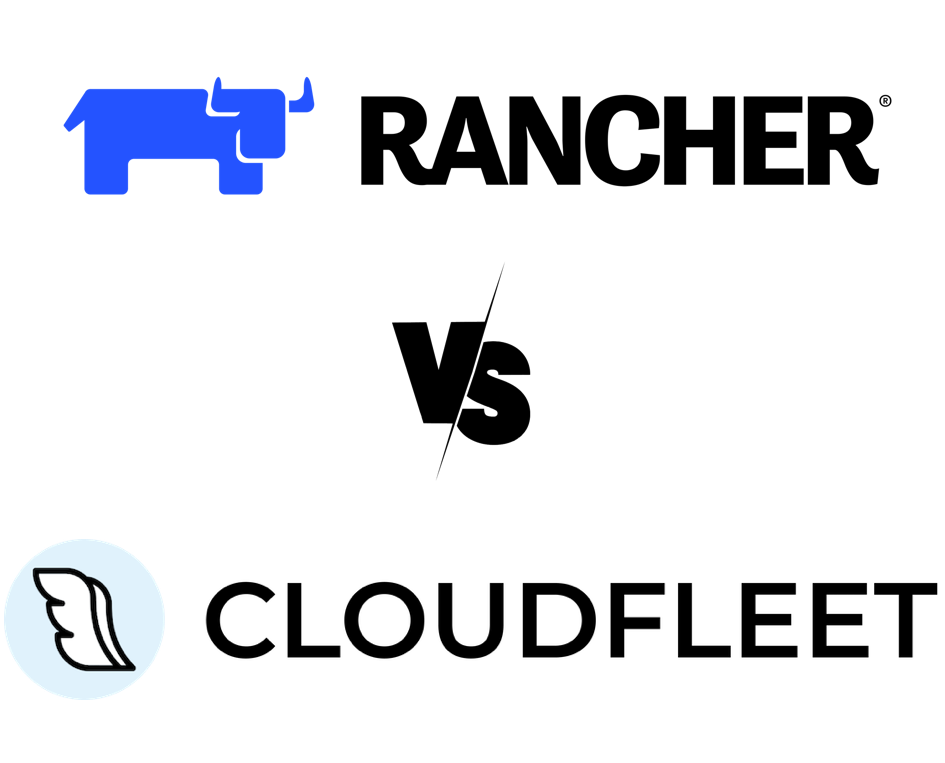Cloudfleet vs. Rancher
A comparison of two different approaches to Kubernetes management - self-hosted multi-cluster orchestration with Rancher versus a fully managed, unified control plane with Cloudfleet


Feature comparison
Rancher is a popular open-source platform designed to simplify the management of multiple, heterogeneous Kubernetes clusters. It excels at providing a single pane of glass for organizations that need to manage a diverse, pre-existing fleet of clusters across different clouds and on-premise data centers.
Cloudfleet addresses the challenge from a different architectural perspective. Instead of managing many separate clusters, Cloudfleet provides a single, unified control plane that spans all your environments. This approach is designed to prevent infrastructure silos from forming, creating a more streamlined and cohesive platform for modern, multi-cloud native applications.
Rancher is an open-source Kubernetes management platform developed by Rancher Labs (now part of SUSE) that simplifies deploying, managing, and securing multiple Kubernetes clusters across any infrastructure. Designed for DevOps and platform teams, Rancher provides a centralized UI and API to handle cluster provisioning, access control, workload deployment, and monitoring. Unlike fully managed Kubernetes services, Rancher is self-hosted, meaning users are responsible for installing and operating the control plane. It integrates with major cloud providers, on-prem environments, and bare-metal servers, making it a flexible solution for organizations that want full control over their Kubernetes environments while benefiting from a unified management layer.
Rancher Prime is the commercial, enterprise-grade offering of Rancher from SUSE, designed to provide production-ready support, enhanced security, and long-term maintenance for organizations running Kubernetes at scale. While it builds on the open-source Rancher platform, Rancher Prime includes additional features such as hardened container images, FIPS-compliant components, and certified integrations tailored to meet stringent enterprise and government requirements. It also comes with access to SUSE’s expert support, guaranteed SLAs, and lifecycle services, making it a preferred choice for companies that require operational stability, compliance, and vendor-backed assurance for mission-critical Kubernetes workloads.
Setting up and deploying solutions with Rancher involves installing and operating the platform yourself, typically on existing infrastructure. Unlike Cloudfleet, which offers a fully managed experience out of the box, Rancher requires manual deployment and ongoing maintenance. While it’s open source and free to start, securely configuring and running Rancher in production demands specialized Rancher expertise. Many teams that adopt Rancher either allocate internal DevOps resources to manage it or upgrade to Rancher Prime for enterprise support - though the commercial offering lacks transparent public pricing, making cost planning less predictable.
The core difference between Rancher and Cloudfleet lies in their architectural approach. Rancher acts as a control plane that orchestrates existing Kubernetes clusters - often provisioned by cloud providers - without owning or managing those clusters directly. In contrast, Cloudfleet delivers its own managed Kubernetes service, including node provisioning, autoscaling, and environment-level orchestration. This enables Cloudfleet clusters to span across clouds and edge locations seamlessly, while also simplifying day-to-day developer workflows. Rancher excels in scenarios where teams need to standardize and manage a fleet of pre-existing Kubernetes clusters, especially in hybrid or legacy environments, but it doesn’t fundamentally reduce complexity for developer operations in the same way Cloudfleet does.
While Rancher provides a solid high-level overview of Kubernetes clusters, it doesn’t come with batteries included. Teams are still responsible for assembling and maintaining a complete toolset for observability, security, CI/CD, and other essential capabilities - often duplicating effort across each cluster and environment. This not only increases operational complexity but also inflates the cost of tooling and licenses over time.
In contrast, Cloudfleet offers an integrated platform where your entire toolchain - monitoring, access control, automation, and more - can seamlessly span across all your infrastructure, including multi-cloud and on-premises environments. This unified approach dramatically reduces both maintenance overhead and the cost of acquiring and managing multiple tool licenses.
When comparing Rancher and Cloudfleet, it’s important to look at how each platform addresses key features across cluster management, developer experience, scalability, and cost optimization.
| Features |

|

|
|---|---|---|
Core ArchitectureThe fundamental approach to managing multi-environment infrastructure. |
Provides a management layer to operate a fleet of separate, independent Kubernetes clusters. | Creates a single, unified Kubernetes cluster that spans multiple clouds and on-premise locations. |
Secure Cloud IntegrationThe method for accessing cloud provider APIs. |
Typically requires manual configuration and rotation of static credentials (e.g., IAM keys) for each cluster. | Integrates Workload Identity Federation for secure, keyless API access to cloud providers, simplifying credential management. |
Support ModelThe scope and nature of available support. |
Community support for open-source. Paid subscriptions support the Rancher software, but you are on your own for the underlying clusters. | Community support is included in the Basic tier. The Pro tier includes end-to-end support with SLAs. Enterprise-grade support is available as an optional addon. |
Pricing ModelThe cost structure of the platform. |
Free and open source to start, but enterprise support requires a per-node SUSE subscription with no public pricing, making long-term costs harder to predict. | Offers a transparent, pay-as-you-go pricing model. The Basic tier is free for individual developers and small teams, while the Pro tier includes enterprise-grade support without hidden fees or per-node licensing. |
Vendor neutralityThe ability to work across different infrastructure providers without vendor lock-in. |
Supports multi-cloud and on-premises deployments through its provider-agnostic architecture, giving teams full control over how and where clusters are deployed. |
Designed to work across all major cloud providers and on-prem infrastructure, allowing users to avoid lock-in while benefiting from a consistent control plane experience. |
Management ModelWho is responsible for managing the platform and its underlying components. |
Self-managed. You are responsible for installing, operating, and upgrading the Rancher platform itself, in addition to all your Kubernetes clusters. |
Fully managed service. Cloudfleet handles the entire lifecycle of the platform, from the control plane to infrastructure, so you can focus on your apps. |
NetworkingHow the platform handles networking across clusters and environments. |
Offers flexible networking options via CNI plugins and cloud-native tooling. Networking configuration is customizable but requires manual setup and expertise across different environments. |
Comes with an encrypted, peer-to-peer overlay network that enables secure, seamless communication across all environments. Cloudfleet supports multi-cloud and on-prem networking out of the box, including DNS and service exposure. |
Cost optimizationHow the platform helps reduce infrastructure and operational costs. |
Provides flexibility to build your own cost-saving strategies using cluster autoscaling, spot instances, and custom tools—but requires manual setup and ongoing optimization by your team. |
Built-in cost optimization features such as dynamic autoscaling, node pooling, and workload-aware provisioning help reduce infrastructure costs with minimal configuration. |
The Cloudfleet Advantage
Comprehensive support for major cloud providers and regions, ready for multi-cloud deployments.
Expand servers, increase storage, or migrate to a different provider with zero downtime - at the push of a button.
High availability is included in the open-source feature set, ensuring reliability for mission-critical applications.
Monitor and manage your cloud infrastructure effortlessly with your preferred tools.
Expert 24/7 support, available 365 days a year. We're here whenever you need us.
End-to-end encryption, isolated networking, dedicated VMs, and full compliance certifications.

Create your free Cloudfleet Kubernetes cluster in minutes - no setup hassle, no cost. Get started instantly with the always-free Basic plan.
Get started →